Starlink RV in 2023, All-You-Can-Eat Motorhome WiFi, At a Cost
Starlink announced Starlink RV in 2022, a new option for mobile internet access in motorhomes and campervans. It ain’t cheap, but it really is a viable option for some, potentially providing fast, reliable, unlimited data across much of Europe (sorry for anyone going to Scandinavia, not you guys just yet). I was intrigued when a friend told me it was available, so did some digging on what it is, what it costs and how it compares to 4G.
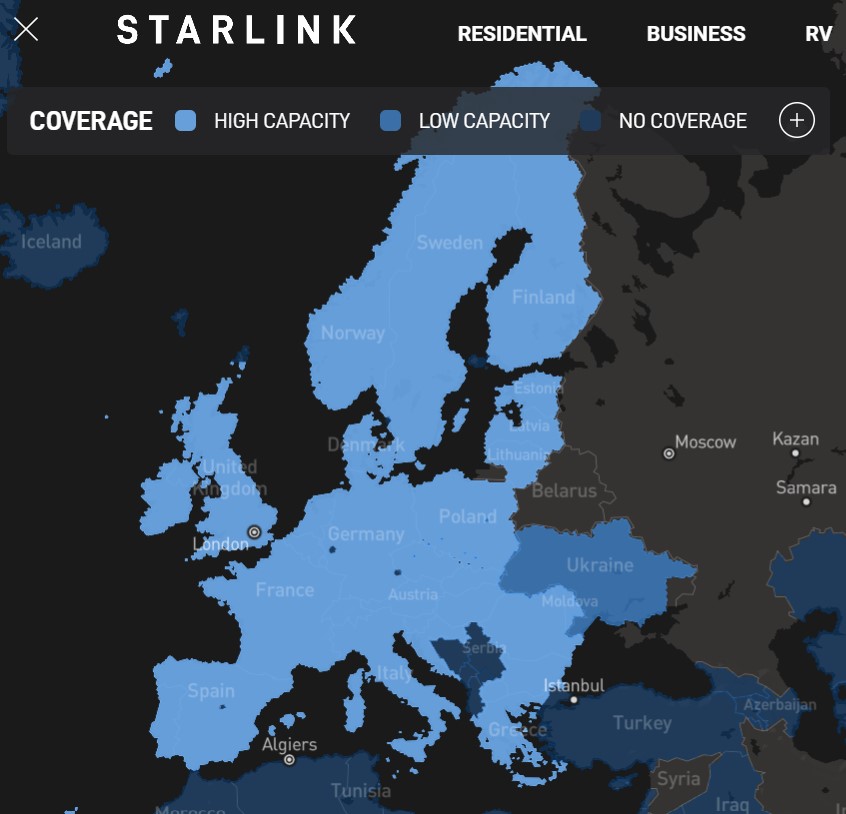
I should make it clear we don’t own a Starlink RV system and haven’t yet personally seen one in use. Have a look at tucktrucks.net for detailed insight from an overlander in North America who’s been using the kit for over a year (they used to keep re-registering their location until the ‘RV’ version of Starlink came available).
Update Aug 2022: just listened to the RV Podcast’s 5 disappointments for their Starlink RV system (available here). Makes interesting listening. Basically this US-based user finds download speeds not as good as expected, and upload speeds very slow indeedy. Worth a listen if you’re interested in this system. His summary is he sees Starlink as a backup to his 4G kit.
Update Oct 2022: Starlink have announced their Flat High Performance Starlink system, which is designed for permanent mounting on a vehicle/boat and can be used in motion. The satellite panel on this model doesn’t sit on a tripod, but uses a flat base (like the roof of a van). I’m not 100% sure when this system will be available in the UK, or how much it costs – the hardware appears to be a fair bit more expensive that the ‘standard’ RV system.
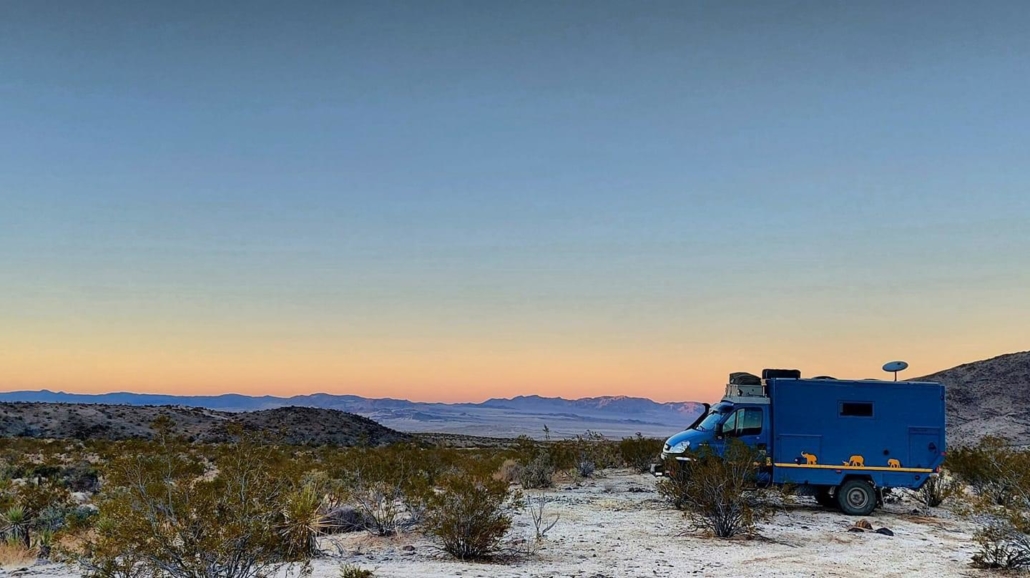
What is Starlink RV?
Starlink RV (from starlink.com) is a satellite internet access service designed for motorhomes. Well, sort of. As far as I can tell, the company has taken their product designed for use in a fixed location, and made it officially work for those moving between locations, like us folks in motorhomes (or second homers, caravanners, anyone wanting to move and take the system with them).
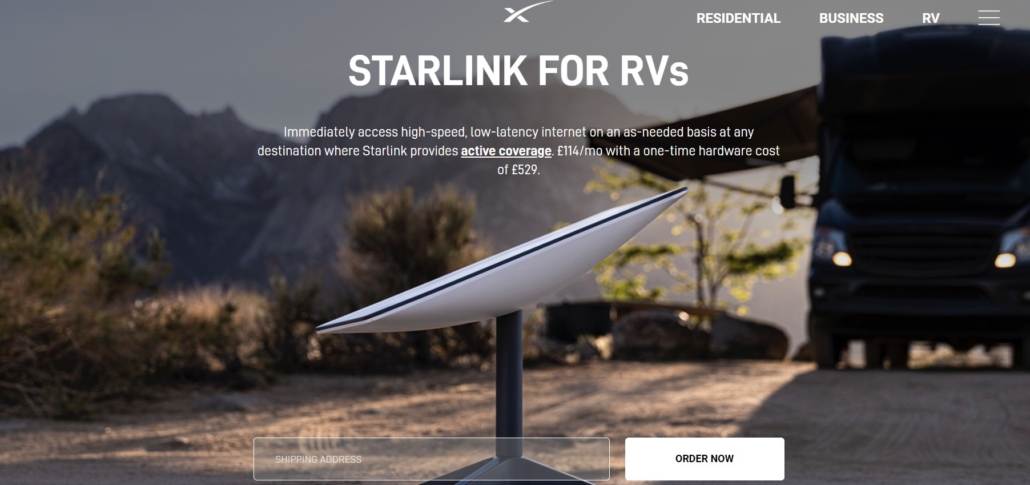
The kit consists of a satellite dish (weirdly/cutely called “Dishy McFlatface”), a small tripod stand and a router, a mains power supply and cables. A couple of points here:
- the dish sits on a tripod, it’s not designed to be mounted to your moho’s roof (the Tucks’ Truck guys above have made a roof mount, but the dish still has to be removed for driving),
- and the power supply needs mains (230V AC) power, rather than running from 12V DC.
So although it’s called ‘Starlink RV’, it’s not been specifically designed for motorhomes and campervans and will be a tad inconvenient to install and use for some of us (more below).
But Haven’t Motorhome Satellite Systems Been Around for Ages?
Yep, pre-Starlink satellite internet systems have been around for over a decade, Catherine and Chris used one on their epic every-country-in-Europe 3 year odyssey. Their kit used a roof-mounted dish and worked with 12V DC (like this Oyster one), specifically designed for motorhomes. No need to place a dish alongside the van or be climbing about on the roof every time you want to use the internet, or drive off after using it. And no need to use an inverter to power the kit when you’re not on campsite mains hook-up.

The main difference for most of us is the fact these systems tended to cost over £3,000 for the hardware alone, plus a hefty monthly fee for internet access. So they were out of the price range for anyone not working a reasonably well-paid remote job (as Chris was, he was a finance director and did 2 days a week on the road for 2 years).
How Much Does Starlink RV Cost?
The Starlink RV equipment and shipping still ain’t cheap. I’ve just popped my address into their order form and it’s coming back with £584 for the equipment, plus an additional £114 per month subscription.
Update Sep 2022: the costs have been reduced to £460 for the kit and £95 per month for the subscription.
Nope, not cheap, but (a) if you’re not on the road full-time and don’t need it at home, you can pause the service for the months when you’re not using it and (b) that’s for unlimited data. Starlink’s specifications advertise download speeds of 50 to 250Mbps, and upload of 10 to 20mbps, so pretty quick! The latency is low too, unlike the older satellite systems, meaning real-time stuff like internet video calls should be responsive.
How Does the Equipment Work?
When you park up, you’ll need to be somewhere with a clear line of sight to the sky (no trees, tall buildings etc). Starlink provide a smartphone app which helps you work out roughly where to point the dish. You then pop the small tripod on the floor (up to 30m from the van) and place the dish on it. You run the wires back to your van and plug in the power supply. Motors in the dish do the final alignment for you, no need for fiddling about with signal strength meters and compasses. Once connected, the router provides a WiFi network which you can hook your phones, laptops, tablets, smart TV and so on up to, and away you go.
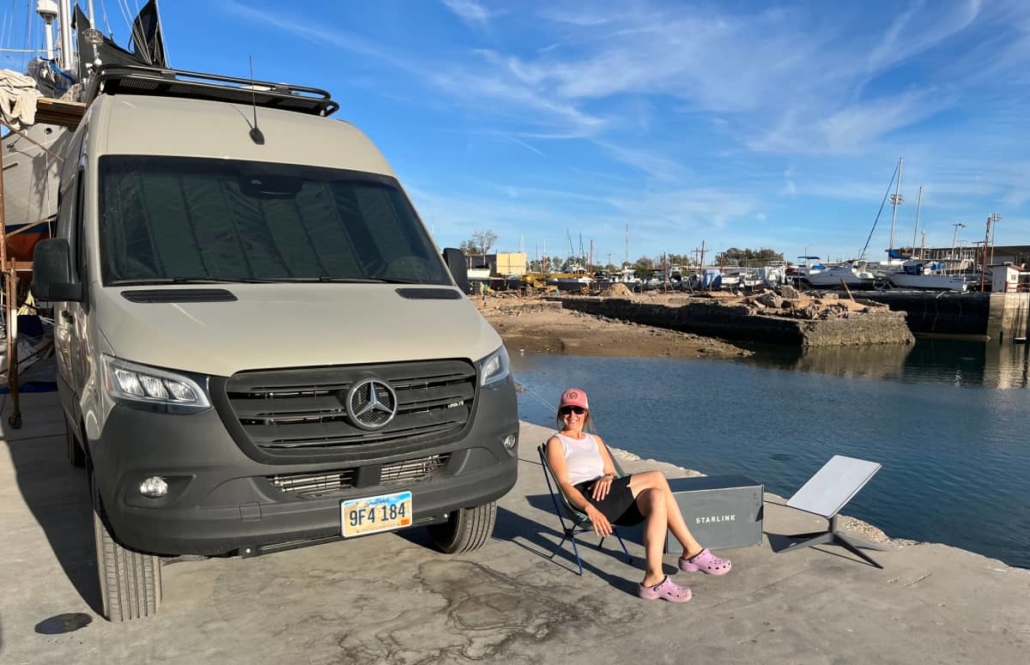
There are a few obvious issues with the way the kit works for motorhomes, nothing major, more inconvenient than anything:
- It needs mains power, so if you’re not on hook-up you’ll need an inverter. Tucks Truck did some analysis and it normally uses about 60W (up to about 150W when it’s in ‘snow melt mode’ – heating up the dish to melt any snow on it!), so a 300W pure-sine inverter will do the job.
- You need to run the cables from the dish to the router, so will need to either fit external glands of some sort, or leave a window, door, vent or locker door open.
- The dish has to be sat somewhere outside, which should be easy enough on a campsite but maybe not so much when you’re in a car park or aire somewhere. Like Tucks’ Truck you could make a roof mount, but the dish isn’t strong enough to sit on it while driving, so you’ll need a ladder and to be happy getting on the roof every time you move the van. A custom-made pole mount attached to the rear of the van could be another option.
What Alternatives Are There to Starlink RV?
The main alternative we all use is our phone’s mobile data connection, or at least a mobile router connected to 3G, 4G and (in a few places) 5G networks. Our system has a roof-mounted antenna which boosts 3G and 4G signals and works really well. We’ve stayed in 1000+ places over the years in our vans and over recent years have only found a very small number of remote spots with no 3G or 4G signal, like Seathwaite Farm in the Lake District and Les Chapieux in the French Alps.

So, mobile data networks are available pretty much everywhere, especially with a roof antenna helping receive and send signals to the nearest mast. Here in the UK we use an unlimited data SIM card in our MiFi which costs £20 a month, much cheaper than a Starlink RV subscription. That said, we typically get speeds of roughly 10mbps, so our system is much slower than the satellite service.
The scenarios where Starlink RV seems to come into its own for UK and European roaming are:
- Where you absolutely must have a fast, reliable internet signal everywhere. If you’re working remotely for example, with fixed days or hours when others rely on you being accessible.
- When you need unlimited data in countries outside of the UK and Ireland. UK-issued SIMs tend to limit roaming data to less than (very roughly speaking, they all vary) 25GB a month and a maximum of 2 months outside the UK (popitmobile.co.uk is a notable exception, offering 100GB a month whichc an be used over a 6 month period).
- If you want to be able to watch a few hours of Internet TV each day (on a FireTV Stick for example), you can easily eat 100GB a month, so you’ll need to be very careful finding a UK roaming SIM which doesn’t end up costing £100s a month.
- You can sometimes buy pay-as-you-go SIM cards outside the UK with larger amounts of data for reasonable amounts of money (this Wiki is the best source of info, plus several people have recommended tiekom.com too, with their 300GB SIM). But, not all countries have these, and they’re often not convenient to buy (unless you speak the local lingo) or top-up (every SIM seems to have a different system).
Starlink RV in Summary
When Ju and I started our first two-year Europe and North Africa tour 11 years ago, we had 25MB of data a day for about £20 a month. We had to write blog posts as text only, publish them and then upload the photos when we could find WiFi at McDonalds or some such. Some days we had to climb a hill to get a weak mobile signal. It makes us smile these days when we pull up on a campsite overlooking the cliffs of Pembrokeshire and, after exploring the local area, pop some internet streaming TV on for the evening! :-)
But we’re not doing much European wandering at the moment. And we’ve never had ‘must be connected at all times’ jobs while on the road. For those that are roaming and need connectivity everywhere, Starlink’s system appears to be a big leap forwards. I can only guess that subscription costs will come down over time, and the system will be better adapted for use on moving vehicles like motorhomes.
What do you reckon to Starlink RV folks? Is it something you can see yourself using? Drop us a comment below.
Cheers, Jay

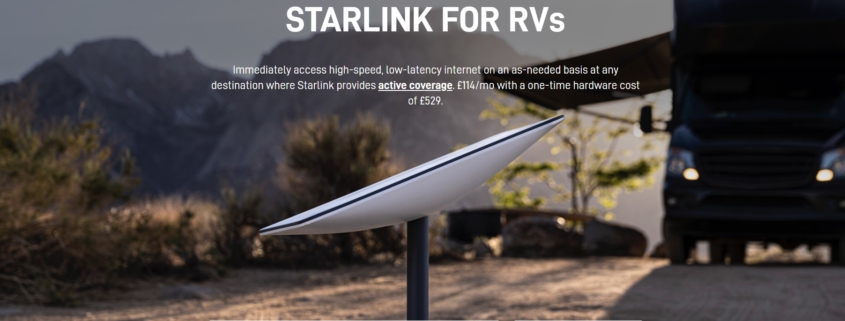


Hey, thanks for doing the research for us! We are off for a US tour for a year soon where coverage is way more patchy than Europe so it’s a consideration although it’s also attractive to theft if not fixed. They have unlimited data sims for $50 pm … if there’s a signal! Thanks